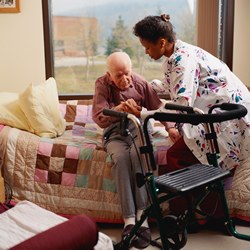Horrible bosses. If you’ve had one, hopefully they were not as bad as those portrayed by Jennifer Aniston, Kevin Spacey, and Colin Farrell in the newly released movie of the same name. While the plot and characters are exaggerated and the comic elements may not be to everyone’s taste, the movie highlights the very real issues of work stress and violence. Each week in the United States, an average of 33,000 workers are assaulted on the job and 14 are murdered. By and large, robbery-related factors account for the toll of homicide at work. The situations portrayed in the movie are not typical—worker-on-worker (or boss) violence accounts for only about 8% of workplace homicides. More than half of all workplace homicides occur in retail or service settings such as conveniences stores, taxicab services, and gas stations with the majority of these homicides occurring during a robbery.
Selected Category: Violence
Horrible Bosses: Workplace violence in the real world
Categories: Media, Stress, Violence
July 18th, 2011 2:47 pm ET - Dan Hartley, EdD
Assaults on Nursing Assistants
Categories: Health care, Violence
November 22nd, 2010 12:45 pm ET - SangWoo Tak, ScD, MPH
 Nursing assistants are a critical part of the dedicated staff who work day and night in nursing homes to keep residents safe, secure, cared-for, and comfortable. Yet the very workers ensuring the safety of our seniors are themselves at risk for workplace violence and assaults.
Nursing assistants are a critical part of the dedicated staff who work day and night in nursing homes to keep residents safe, secure, cared-for, and comfortable. Yet the very workers ensuring the safety of our seniors are themselves at risk for workplace violence and assaults.
Recent NIOSH research based on the first large, nationally representative sample of nursing assistants reported that that nursing assistants in nursing homes have a high rate of work-related physical injuries from assault.1 Overall, 35% of nursing assistants reported physical injuries resulting from aggression by residents, and 12% reported experiencing a human bite during the year before the interview. Nursing assistants employed at nursing homes with special units for Alzheimer patients had a significantly elevated risk for assault injuries and human bites (37% reported injuries from assaults and 13% reported human bites).
Violence Against Pharmacists
Categories: Violence
February 17th, 2009 11:07 am ET - Administrator
 Since the early 1990s, the National Institute for Occupational Safety and Health has conducted research on and provided recommendations for preventing workplace violence. Efforts had focused on the highest risk occupations, including taxicab drivers and convenience-store workers. In 2002, NIOSH released the document Violence: Occupational Hazards in Hospitals. The document found that the circumstances surrounding violence in hospitals differed from those of workplace violence in general. In other workplaces such as convenience stores and taxicabs, violence most often relates to robbery. Violence in hospitals usually results from patients and occasionally from their family members who feel frustrated, vulnerable, and out of control.
Since the early 1990s, the National Institute for Occupational Safety and Health has conducted research on and provided recommendations for preventing workplace violence. Efforts had focused on the highest risk occupations, including taxicab drivers and convenience-store workers. In 2002, NIOSH released the document Violence: Occupational Hazards in Hospitals. The document found that the circumstances surrounding violence in hospitals differed from those of workplace violence in general. In other workplaces such as convenience stores and taxicabs, violence most often relates to robbery. Violence in hospitals usually results from patients and occasionally from their family members who feel frustrated, vulnerable, and out of control.
We are finding that violence against pharmacists differs from violence experienced by other healthcare workers.
Preventing Violence against Taxicab Drivers
Categories: Vehicle safety, Violence
June 16th, 2008 9:07 am ET - Administrator

Digital security camera head mounted over the rear-view mirror in a Winnipeg taxicab. By Richard Kellie
Homicide is consistently among the top causes of work-related deaths. While the National Institute for Occupational Safety and Health (NIOSH) and others have reported since the 1990s that the taxicab industry has a very high occurrence of workplace homicide, some are still surprised to learn that taxicab drivers face a greater risk for injury and homicide on the job than those working in law enforcement and security.
To date, very little epidemiologic research has been conducted on the circumstances surrounding taxicab driver homicides and assaults, and it remains unclear which safety interventions are most effective in reducing violence-related injuries. There are several types of safety equipment available to taxicab companies, such as cameras, partitions, GPS devices, and alert systems. While partitions appear to be effective in reducing homicides (based on studies of their use in Baltimore, New York City, and Winnipeg), they have not been widely accepted by the industry.
Older Posts
Pages
- [1]
- 2
Get email updates
To receive weekly email updates about this site, enter your email address:
Site Categories
- Agriculture, forestry, and fishing
- At-risk populations
- Bloodborne pathogens
- Cancer, reproductive and cardiovascular diseases
- Chemicals
- Construction
- Economics
- Emergency response
- Ergonomics
- Exposure
- Green
- Health care
- Hearing loss
- Media
- Mining
- Nanotechnology
- Oil and gas
- Outdoor work
- Personal protective equipment
- Policy and programs
- Prevention through Design
- Respiratory health
- Sleep
- Small Business
- Sports and entertainment
- Stress
- Technology
- Total Worker Health
- Training
- Transportation
- Uncategorized
- Vehicle safety
- Violence
- Young Workers
About this Site
Contact Us:
- Centers for Disease Control and Prevention
1600 Clifton Rd
Atlanta, GA 30333 - 800-CDC-INFO
(800-232-4636)
TTY: (888) 232-6348 - cdcinfo@cdc.gov

